#zambot 3
Explore tagged Tumblr posts
Text

25 notes
·
View notes
Text
An Abbreviated History of Mecha Part 2: AWAKEN! SUPER ROBOT!!! (1970-1979)

(Read in the voice of Tessho Genda) ITS NAME IS.... MAZINGER.... Z!!!!!!!!!
Welcome back to An Abbreviated History of Mecha. Last time, we covered the origins of mecha by highlighting some of the major works of the time including Godzilla and Ultraman, which are not really mecha but are just as influential to the genre as the other shows mentioned.
Today, we will be moving on to the 70's. Here we will see three extremely iconic entries to the canon make their grand entrances, known to Super Robot Wars fans as the Holy Trinity. We'll also see a lot of the classic mecha tropes become codified with a lot of these entries. So, let's MAZIIIN GO!
Kamen Rider (1971)

Kamen Rider is the second iconic series created by mangaka Shotaro Ishinomori and would be part of the reason why henshin heroes (that is, heroes who transform) would become so popular. More importantly, Kamen Rider would give us one of the most homaged attacks of all time: the Rider Kick! And in case you're wondering, yes, Ishinomori still has one more series worth mentioning.
Kamen Rider, alongside Godzilla and Ultraman, got a 2023 retelling in the form of Shin Kamen Rider, courtesy of Hideaki Anno.
Mazinger Z (1973)

Mazinger Z is one of the many iconic series created by legendary mangaka Go Nagai. If Tetsujin 28 was the original "super robot", Mazinger Z would be the series that would introduce a lot of the tropes now commonly associated with a lot of giant robot anime, including but not limited to:
A robot that has to be piloted from the inside
A chest blaster
Laser eyes
Hot-blooded pilots
The term "super robot"
And most important of all, the rocket punch
Let's just say that there's a good reason why Mazinger Z (and this is just Mazinger Z) is the first of the three pillars of the Holy Trinity. Mazinger also has, in terms of sequels and adaptations:
Great Mazinger
UFO Robot Grendizer
Mazinkaiser
Shin Mazinger Z/Mazinger Edition Z: The Impact
Mazinger Z Infinity
Getter Robo (1974)

Created by Ken Ishikawa with help from Go Nagai, Getter Robo would be the second pillar of the Holy Trinity alongside Mazinger Z. Getter Robo would be important for introducing concepts such as a robot piloted by multiple people and, more importantly, Getter Robo would also introduce us to the combining robot, which is why it requires multiple pilots to man.
Getter Robo would get multiple sequels and spinoffs including, but not limited to:
Getter Robo G
Getter Robo Go
Shin Getter Robo Armageddon!
Shin Getter Robo vs Getter Robo Go
New Getter Robo (not to be confused with Shin Getter Robo)
Getter Robo Devolution
Eventually Ken Ishikawa would pass away before he could wrap up the series with Getter Robo Arc. I will come back to Getter Robo at some point in this series though, but to give you a hint: the series does get a conclusion.
I think I'd also be mistaken not to link to Cheese GX's excellent video retrospective on Getter Robo.
Super Sentai (1975)
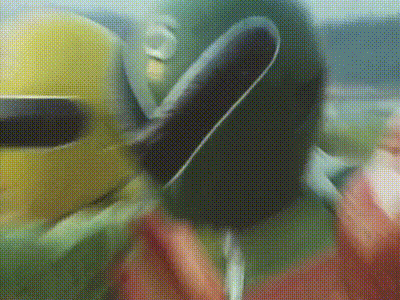
Because Shotaro Ishinomori wasn't content with creating two iconic series, he went ahead and made a third: Super Sentai. That's right: Ishinomori created the two most iconic versions of the henshin hero. Super Sentai is worth mentioning here due to the fact that the series would eventually start adding giant robots into the mix. This series would also eventually attract the attention of one Haim Saban, but that's a story for another day.
Microman/Microbots (1974)
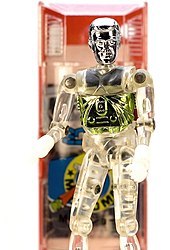
Microman (the toy, not the wrestler) was a line of, and I'm not joking when I say this, "Tiny Little Guys" released in 1975 by the toy company Takara. I'm not super familiar with Microman, but I feel it is important to mention Microman here to understand that one of the biggest names in mecha is descended from this line of toys, as it would start out as a spinoff of microman. Something about transforming vehicles the micromen could pilot. Who could know?
Also fun fact, there's a wrestler named Microman.
Brave Raideen (1975)

(We'll have to settle with this clip from Super Robot Wars)
Brave Raideen is a series created by Studio Sunrise and is one of the first giant robots that is considered to be supernatural in origin. Raideen is important in the history of mecha as it is where two important figures would come into play: Yoshiyuki Tomino and Tadao Nagahama. While it is largely overshadowed by other bigger series, Raideen is still important due to it being the first stepping stone for those two directors alone.
Space Battleship Yamato/Star Blazers (1975)

Up next is Leiji Matsumoto's legendary Space Battleship Yamato. This series would be one of those watershed moments in anime history as Yamato would prove that there was, in fact, an audience who wanted more serious war stories. To say that this series isn't that influential would be a mistake, as we will soon see.
Space Battleship Yamato would eventually receive multiple adaptations, including a live-action film and an anime reboot in the new millennium. The success of Yamato would also help pave the way for other Leiji Matsumoto works like Space Pirate Captain Harlock and the Galaxy Railway 999.
The Robot Romance Trilogy (1976-1979)

(Pictured above: Voltes V)
The Robot Romance Trilogy is a thematic trilogy created by Toei and directed by Tadao Nagahama. These series would include:
Super Electromagnetic Robot Combattler V (V as in the letter)
Super Electromagnetic Robot Voltes V (V as in the number)
Fighting General Daimos
The Robot Romance Trilogy is known for building off of the innovations of its peers. Whereas Getter Robo combined by smashing three jets together (and thus was hard to translate into a toy), Combattler V was designed in a way where the parts of the robots actually made sense when combining to form the robot. This also doesn't even touch on the fact this trilogy would also help to popularize things like the five man band (alongside Super Sentai), mecha shows having more serious storylines with melodrama, and funnily enough, the motion capture mecha (specifically Daimos).
Voltes V is also extremely popular in the Philippines. While this isn't unheard of at this time, Voltes V was different in that it was banned from airing on television by the Marcos regime. Speculation behind its ban may be that its themes were similar to the plight of the Filipino people under Marcos, so you could say that Voltes V in particular is a symbol of rebellion in the Philippines. Heck, it was so popular that there now exists a live action Voltes V series filmed in the Philippines.
Zambot 3 & Daitarn 3 (1977 & 1978)

(Pictured above: Zambot 3)
Meanwhile, Yoshiyuki Tomino would continue to push boundaries as he got more into the groove of directing. On top of producing Voltes V (according to Wikipedia), Tomino would work on a few more series before the end of this decade. The first two would help to establish a pattern with Tomino's works, where he would follow up a more serious and depressing series with something more lighthearted and silly. Zambot 3 would help Tomino earn his nickname "Kill 'Em All Tomino," while Daitarn 3 would also show that he knew how to relax when working on a series. Both Zambot 3 and Daitarn 3 were big hits, but the next series would forever cement Tomino as a legendary figure in the world of anime and manga.
Mobile Suit Gundam (1979)

Mobile Suit Gundam, the final pillar of the Holy Trinity, is arguably Yoshiyuki Tomino and Sunrise's single most important series date. Arguably the single most famous mecha of all time, Gundam would be the first giant robot to be treated less as a hero and more as a tool of war, and it would be Gundam who would kick off a new generation of mecha stories that focused more on things like war and how it affects the lives of the characters in these stories. Which is funny, because Gundam was initially a flop at first. Over time, the series would eventually become a hit thanks to its compilation movies as well as the sale of its models and, most important of all, its female fans.
Mobile Suit Gundam would also be a watershed moment in animation history, as it would be the introduction to a lot of people who would also become famous thanks in part to this series. This includes people who worked on the show like Yasuhiko Yoshikazu (the character designer), Kunio Okawara (mechanical designer, and arguably the first credited mechanical designer), and Ichiro Itano (animator, the same man who Itano Circus is named after). Gundam would also be a direct inspiration for one Ryousuke Takahashi, who would begin to really push the boundary for what one could do with military mecha shows.
Conclusion
I hope this was an enjoyable read. Next time, we'll be getting into the 80's, where we will begin to see a lot of series pop up as Japan's economy grows at an exponential rate. We'll also see how these giant machines will come to influence people outside of Japan on top of how they build off of the themes present in the first Gundam.
Will you survive?
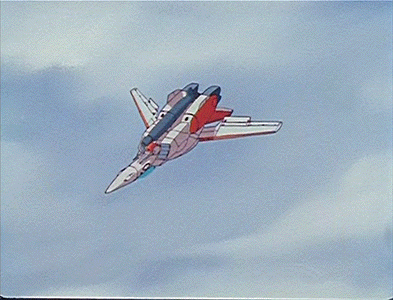
#anime and manga#mecha#an abbreviated history of mecha#mazinger z#getter robo#robot romance trilogy#combattler v#brave raideen#zambot 3#daitarn 3#voltes v#daimos#space battleship yamato#mobile suit gundam#kamen rider#super sentai#microbots#microman#the toy not the wrestler
23 notes
·
View notes
Text

Muteki Choujin Zambot 3 episode 3
8 notes
·
View notes
Text

i forgor to fucking post this but i posted it a day late in twitter for Toshio Furukawa's bday-
Characters from left to right!
Kouzuki Shingo, Piccolo, Kamie Uchuta and Kai Shiden!
Kouzuki and Uchuta are from Zambot 3, although Furukawa only voiced Uchuta for a few episodes. (Katsuji Mori is Uchuta's main VA.)
#mobile suit gundam#dragon ball#piccolo#kouzuki shingo#kamie uchuta#zambot 3#kai shiden#gundam 0079#thank u furukawa for bringing my babygirl (kai shiden) to life istg i would not be here frothing at the mouth had it not been for u#ignore the fact that i didnt color the eyes i dont wanna fix it
35 notes
·
View notes
Text
Zambot 3
Opening dell'anime L'invincibile Zambot3

5 notes
·
View notes
Text

1977年 無敵超人ザンボット3 その1 ザンボット3 by Sakaki
8 notes
·
View notes
Text

Lol if I sell a single Zambot sticker I’ll laugh my ass off
#illustration#artists on tumblr#anime fanart#gundam#Zambot 3#victory gundam#mobile suit gundam#mobile suit victory gundam
4 notes
·
View notes
Text



✿ Muteki Choujin Zambot 3 ┊ 40 sheets ✿
… a 1977 TV series with character designs by Yoshikazu Yasuhiko is now available over here.
#Muteki Choujin Zambot 3#anime#70s anime#retro#retro anime#model sheet#character design#character sheet#Yoshikazu Yasuhiko#mecha
8 notes
·
View notes
Text
As someone who loves the mecha genre I wish I was into any of the Gundam series but so far I have been unsuccessful.
I love the aesthetic of a giant robot with a big fuck off gun, if I didn’t I wouldn’t have gotten Armored Core VI lol, but still, I tried watching 79 quite a few times but fell off each times.
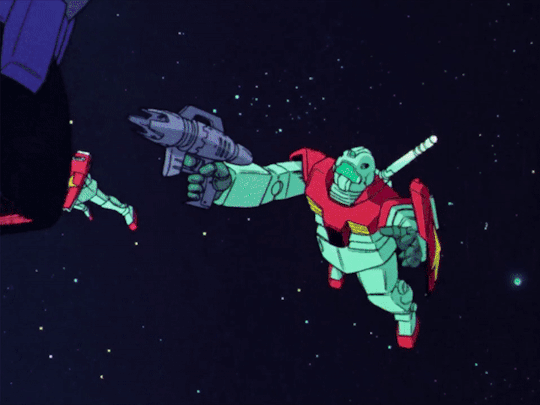
The first time was when I watched the first ten episodes of the original series off of a piracy site when they were still untamed by the feds, and just never returned to it. Then my second attempt was with the movie trilogy, I finished the first one and then dropped the second halfway through.
It’s been a while but I can try to explain why, I know what Didn’t spoil it for me: I have a stupidly high tolerance for old anime and old media in general, I was Raised on that shit, including many of Sunrise’s anime from the time, so I didn’t care because it looked old or outdated.

No I think what got me the most, and this might be an issue with the movies since I do remember some good episodes they had to cut out for time, was the characters, ironically. I’m sorry but I couldn’t care less for Amuro, he’s boring as hell and very generic… and he’s ginger (I’m kidding), when he’s not fighting he’s either ranting or getting beaten up by Bright and OH I’ll get to that cunt soon.
Idk maybe I hold up Shinji as the definitive example of how to make traumatised underage pilots, and Amuro just isn’t enough of a mess to work here despite the setting, and for the record I Like Shinji as a character.

My other issue is with a lot of the women in the cast, again, I didn’t finish the series so it prob gets better but a lot of the women in this show do nothing but stand around, cry, die, or keep repeating AMURO AMURO AMURO AMURO AMURO if they’re on the side of the Federation. I have seen films from the 50s with more feminist depictions of women ffs.
Now onto Bright, I like to think that my media literacy is good enough for me to not let characters who are bad people get to me, au contraire, some of my favourite pieces of media often involved the Whole Cast being pieces of shit, I am a massive Always Sunny fan after all. I can live with unsavoury characters if they’re done well enough.
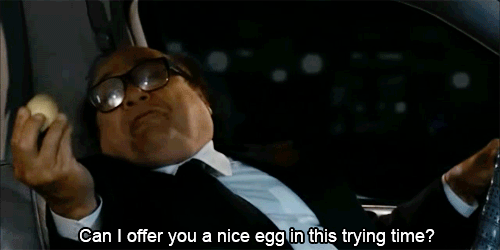
That being said, I could never shake off the feeling that the series wasn’t doing quite Enough to call out Bright’s hardass martial approach to social interactions, almost as if the series was saying “yup, he’s in the right brah, nothing wrong here” which yeah this set the stage for me to bounce off the series incredibly hard in the second movie I think where he says some shit about women not being allowed to pilot mechs.
I really hope I’m misremembering some of this stuff because brother that’s not it. Really the only characters I really cared for where the villains like Char and the other guy, since they go against what you’d expect from mecha baddies, but even still they don’t have that much screentime and one of them famously dies in the tenth episode or the climax of the first movie.
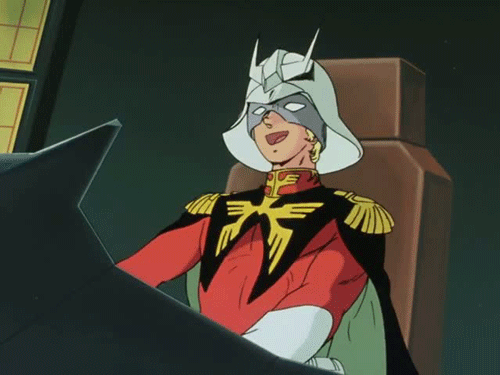
But those were my issues with the series itself, on a more meta level, I have some amount of resentment over the series specifically the original 79 for its impact.
For those who don’t know, mecha series before Gundam were retroactively labelled as “Super Robot” since they were basically giant metal superheroes, animated Ultraman essentially, they could jump, move and run like it was nothing despite the laws of physics, and had extravagant weapons and attacks fighting whacky aliens or evil scientists.

Even Sunrise’s previous works like Daitarn 3 and Trider G7 were super robot through and through, especially the former being downright comedic at times and being closer to James Bond than science fiction, even their supposedly darker Zambot 3 was super robot through and through.

So when the original MSG came out in 1979, it really was a big deal as it was unlike everything else; it was a lot more grounded in tone and setting, the villains not only were fellow humans but had layers of complexity and weren’t just cartoon baddies, the robots carried shields and guns instead of cock-rockets and roketto-panchi, it was less a superhero Kyodai/Kaiju romp and more like a war drama, the severity of the conflict was made front and centre and not brushed aside for the cool fights.
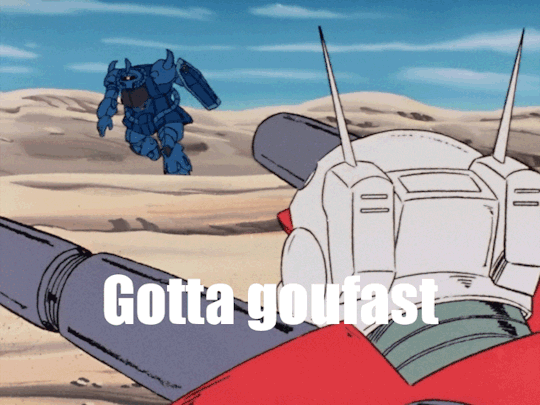
That’s brilliant, even to this day it’s a great premise and deconstruction of the mecha genre, the problem is that this series became So popular that basically every single fucking mecha and scifi anime had to model itself after Gundam or be seen as outdated. Super robot was killed overnight, because god forbid we have some fucking fun with the concept of GIANT ROBOTS BEATING THE BRAINS OUT OF EACH OTHER.
Like Gurren Lagann being modelled after super robot shows as a fun throwback shows how utterly dead the genre is.

I understand that by the time Gundam came out the genre had run its course, you can only rewrite Mazinger/Grandeizer so many times, but fuck’s sake surely there’s ways to do it just be creative. I love the things Gundam helped create but the fact that it had to exist at the Expense of super robot is what bothers me.
Let me explain it by comparing it to Godzilla ok? There’s two kinds of Godzillas: serious war drama Godzilla and KWE standing for Kaiju Wrestling Entertainment. There’s fans that prefer one over the other but both Godzillas exist without cancelling each other out.
Now the 1980s movie The Return of Godzilla was the first movie in the series in a while, and it was a grittier more serious return to form that just had Zilla destroy a city without all the other monsters duking it out. Now IMAGINE if after that movie Toho went “right, it’s clear, people only want serious Godzilla it’s very clear” and from then on we ONLY got movies like Godzilla 54, Minus One and Shin Godzilla, yes they’re peak, but after a while a part of the fanbase is gonna get seriously tired of them and wish they would just get “Godzilla vs Mothra vs Kong vs Gheedora All United Brawl” already.
Now if you know me personally you’ll ask “but what about Evangelion” and yes, if Eva is not my favourite anime ever it’s in the Top 3, but honestly? Calling Eva just a mecha show or any of the sub genres is seriously selling it short, it is SO much more then robot fights and thats why I love it, watching Eva just for the robot fights is like playing Silent Hill 2 for the riveting combat.
So those are my thoughts, I still haven’t given up on the series as I plan to revisit it through War in the Pocket since fans quite like that one in particular, hopefully it’s more up my alley lol.

#mecha#1970s#robot#real robot#super robot#gundam#mobile suit gundam#gurren lagann#ufo robot grendizer#great mazinger#godzilla#sunrise#anime
27 notes
·
View notes
Text
im passively in some mecha circles on twitter but dont go out of my way to meet anyone new on discord so the Mecha Posting Experience is pretty different. if i post "im watching zambot 3!" the twitter response is "i see ur watching peak" but the discord response is "youre making up shows to piss me off"
9 notes
·
View notes
Note
What if 'Gundam SEED' was told from Flay's point of view? How would they approach it? Would it have been better?
Supposedly, a canned storyline had her being turned into a human bomb by Rau. Sounds like epic SRW bad end scenario to do with Zambot 3.
SEED's problem is the writing flip flopping on what it wanted to do. Andy's reconnect death is the most blatant example of going back on what they were building towards.
If they wanted to do idealistic show from the start, I wouldn't hold it against it. AGE has flaws of its own, but I don't hold against it that it wanted to be idealistic. It was consistent with it.
But SEED wanted to do teenage sex manipulation, build up towards dangerous berserk status, and then had a conclusion filled with elements that did not fit with it.
It is similar with Cross Ange, which was made by the same director. Grimdark like hell, until the main mech is activated and the series changes completely.
SEED has an identity problem. A lack of consistent vision problem. If you decide on a particular identity and vision and run with it to the end, you should already do better. Regardless if you make Flay MC or whoever else.
5 notes
·
View notes
Text
Mecha's "I'm Not Like the Other Girls" Problem
Preface: I'd like to apologize to everyone who reads this post. Normally, my posts are pretty lighthearted and informative. This one, however, is not lighthearted.
I feel it is important to talk about this topic though, as this is a problem that has been plaguing mecha shows for a long time now. It bothers me when people dismiss the things that I like *gestures at G Gundam*, so it should be of no surprise that I have strong feelings about this topic. It's pretty adjacent to the reason why I don't like the "Real vs Super Robot" dick-measuring contests that happen between fans, especially as someone whose favorite mecha show gets a lot of heat because of that stupid debate.
Part of what makes it worse is that I don't dislike these shows a whole lot. Okay, two of them I don't like a whole lot, but one is because its second season really drops the ball on things while the other is, in my opinion, a pretty mediocre show that is being propped up as the hottest thing since sliced bread by its fans.
I'm also going to be talking about gen:Lock, a show that I hate from pure pop cultural osmosis. So content warning: suicide, children getting killed, and gen:Lock, among other things.
Stop me if you've heard this one before:
"Evangelion's not like other mecha shows because it focuses on the character drama instead of the robots."

If you've ever watched any mecha show ever, you'd realize just how bizarre this line really is. There's always some variation where it'll be the favorite series of the person saying this and, when confronted, will bare their ass out for the world to see by showing that they have not watched any other mecha show. If you're lucky, they might have watched one or two other mecha shows, and chances are likely that it will be one of the other "Not Like the Other Girl" shows.
So today, for something a bit lighter in comparison to my soul-crushing Abbreviated History of Mecha, I'm going to take my turn dismantling this braindead take. Really take my turn at this dead horse, because it is something that plagues this genre of stories.
Context: Evangelion's Legacy Is Exaggerated

Thank you, cast of the hit anime series Neon Genesis Evangelion. I felt brave just saying that.
Jokes aside, I feel it is important to get this out of the way now. And, to be fair, Evangelion is critically acclaimed for a reason. Eva's success did leave an impact on the rest of the industry. A whole generation of anime shows have tried to capture the same energy that Eva had, leading to the rise of the extremely nebulous sekai-kei trend. This isn't even touching on the fact that Eva is also one of the most popular mecha franchises of all time.
That being said, the problem with Eva's legacy is that people in the west exaggerated its legacy. So instead of it being an important series that builds off of the legacy of the shows it was inspired by in order to create something new and just as noteworthy as its forebears, it is now this transgressive series that brutally deconstructs mecha on top of everything mentioned prior. Evangelion became a series that was more than most mecha shows, since it really spends a lot of its time with its characters, particularly the Eva pilots and their handler. Evangelion was different because it was about the characters and not the giant robots.
...Except, that's not true.
This is Ideon Erasure
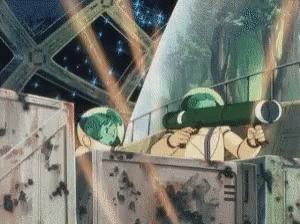
One of the shows that inspired Evangelion, Space Runaway Ideon, is about as serious as they come. It's a story about the horrors of war, and the characters have to contend with this and press on. And while it might not be as introspective as say Evangelion, the difference is what both had as inspiration: Ideon only had shows like Space Battleship Yamato, Voltes V, Zambot 3, and Mobile Suit Gundam as reference points. Evangelion has all four of those shows as well as other shows like Fang of the Sun Dougram, Super Dimension Fortress Macross, and Legend of the Galactic Heroes among other shows to reference
I'm not saying that those shows also influenced Evangelion. I'm just pointing out that, in the history of mecha, Eva has more things to be compared to. And to be fair to the people who kickstarted the "Eva's not like the other girls" mentality, the west's experience with mecha prior to Eva was either shows like Transformers, which existed largely to sell toys, or shows like Gundam Wing, where a lot of the show can be seen as "Wow, cool robot." So along comes Evangelion with its esoteric Christian imagery, brooding protagonists, and eldritch antagonists. It's really nothing anyone in the west has seen before, and so the "Not Like the Other Girls" meme is born.
And now, I'd like to go into debunking this line of thinking with a lot of the big offenders. Because it turns out that Evangelion is not the only show to get this treatment. And if you thought Eva was a bad example of "Not Being Like the Other Girls," then oh boy are these examples somehow worse.
Case Study 1 - Code Geass: Casval Lelouch of the Rebellion

Code Geass is probably the closest example to in terms of being "Not Like the Other Girls" that isn't Evagenlion itself. Like Evangelion before it, Code Geass has more of a focus on its characters than its mech action. A fair bit of screen time is spent focused on the politicking and strategizing and brainwashing (with actual, factual magic) of our main character, Lelouch Code Geass Lamperouge, with all of the shenanigans that ensue. It's a series with a unique spin on the military robot shows of old due to its inclusion of magic (namely the titular Geass) and advanced super materials like Sakuradite (based off of the mythical metal hi'hiirokane or scarletite).
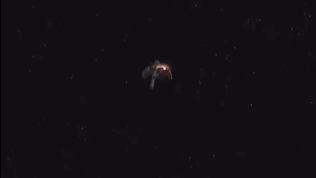
The problem with Code Geass being a "Not Like the Other Girls" show is twofold:
The robots of Code Geass, here known as Knightmare Frames, play a pivotal part in the story. The Knightmare Frames are what allow Britannia to take over the world as well as they do, and a big focus on the series is just how advanced the latest Knightmare Frame, Lancelot, is compared to the other Knightmare Frames. Season 2 exacerbates this problem when the elite Knightmare Frames like Lancelot are constantly getting exponentially more upgrades throughout the season.
It's also hard not to ignore the similarities between this show and Mobile Suit Gundam (the original, not the franchise as a whole). Consider that Code Geass' main character is, for lack of a better word, a Char clone. He wears a mask and oftentimes hides his true motives, which helps when it comes time for politics. He's even got a special power that helps him with his core skills. The only thing Lelouch is lacking is the piloting skill, which is where Kallen Kouzuki comes in (and fun fact: her signature Knightmare Frame, the Guren MK II, is red).
Oh, I should also mention this here: before working on Code Geass, Goro Taniguchi worked on Gun x Sword, which is unabashedly a giant robot anime. Does this really add anything to my point? Not really. I just think it's interesting to point this out due to Gun x Sword's proximity to Code Geass in terms of release dates.
Case Study 2 - Tengen Toppa Getter Robo Gurren Lagann
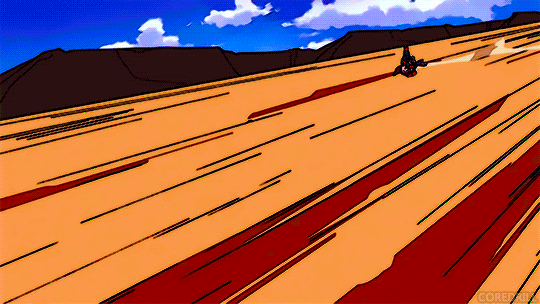
Probably the single most insane version of this is when people treat Tengen Toppa Gurren Lagann as being "Not Like the Other Girls."
Y'know... Gurren Lagann. The show where the giant robots grow as large as the known universe. A show where one of the major thematic elements is a celebration of giant robot shows that's reflected in the four major story arcs representing a distillation of the four decades of giant robot shows from as early as Mazinger Z. A show where the main character draws a lot of his self worth from, among other things, how well he pilots his mini robot (a gender-swapped Noa Izumi, if you will).
Oh, and most important of all: this is also the show written by, and I'm not making this up, a man who refers to himself as Getter Robo's number one fan.

This doesn't even touch on other shows that one could argue also had a hand in influencing Gurren Lagann like Mobile Fighter G Gundam and The King of Braves, GaoGaiGar. Look me in the eye and tell me that Kamina wasn't written with characters like Domon Kasshu and Guy Shishioh in mind. Or the fact that Simon the Digger is less Ryouma Nagare and more Domon Kasshu by way of Guy Shishioh.
In the case of Gurren Lagann, though, it should also be of no surprise that this is the series brought up the least amongst the "Not Like the Other Girls" shows. A big part of this stems from, as I mentioned earlier, the fact that Gurren Lagann is a celebration of giant robots.
...What's that? Why does it sound like an axe is being sharpened in the background? No, reader, you're hearing things. I clearly don't have an axe to grind with the next show.
Case Study 3 - Armored Trooper 86: Eighty Six
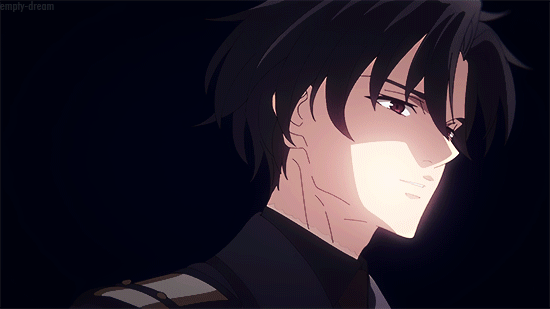
Part of what I hate about the modern seasonal anime release schedule is that it's created an entire generation of anime fans who refuse to watch any series that released before 2010. This line of thinking can be pretty dangerous, and this is coming from a guy who's always saying the newer Pokemon games are generally better than the older ones. The difference is twofold:
Pokemon isn't anywhere near as old as all of anime. Like it's not even close to being that old.
This only really applies to core game mechanics in the mainline non-Legends games. It doesn't really take into account things like story elements, Pokemon rosters, or generation design differences (read as: is the game pre- or post-Physical/Special split).
I'm bringing this up because I feel like the seasonal anime format is the reason why 86: Eighty Six became a "Not Like the Other Girl" show. As someone who watches a lot of mecha shows, 86 is just...
...it's there. It exists. In my opinion, 86 doesn't really have a whole to say outside of racism is bad and look at how much Shin and company suffer because of it. Everything 86 does has been done before in some fashion by literally every military robot series that existed prior to 86's first publication in 2017. Heck, two years prior to it's publication was the first airing of Mobile Suit Gundam: Iron-Blooded Orphans, the then-latest entry in the Gundam franchise. And that series is all about how unfettered capitalism makes it almost impossible for the marginalized to survive without having to resort to violence.

But I think it's folly to suggest fans of 86 to go watch Iron-Blooded Orphans. Not because it's bad, which I'd argue that it's not. No, it's more because IBO is too recent. Part of the problem with the "Not Like the Other Girls" mentality is that people will limit themselves into only watching one show, oftentimes failing to see that part of what makes their favorite show so special is the fact that it is inspired by other works. For people who like 86, it would be better to recommend shows like Armored Trooper VOTOMs, Fang of the Sun Dougram (or really any military robot series directed by Ryousuke Takahashi), or even the original Gundam from 1979. But as harsh as I may be on 86, it's not the worst offender. I'd even go so far as to say that 86 is, at worst, a symptom. I think the real problem lies with the next series I'm going to talk about.
The Worst Offender - gen:Lock

If you thought I disliked 86 because of how its fans hype it up as being better and so much different than the rest of the canon, at least 86 is a pretty entertaining watch.
gen:Lock makes me turn into AM from I Have No Mouth And I Must Scream. To describe the enmity I have towards gen:Lock is not something I want to fully unload on this blog, as it is this series that really kicked the "Not Like the Other Girls" mentality into overdrive. gen:Lock was once described by one of its executive producers as being about the characters and not the robots. Which kind of spits in the face of the canon of mecha in its entirety, as the entire genre has almost never really frontlined the machines as being the main character. And when mecha stories are about the machines, the machine tends to be a character in its own right.
And if I'm being honest, part of what makes me so livid about gen:Lock is how this series basically funneled away funds from other projects at Rooster Teeth. That's what got series creator Gray Haddock fired, after all. So you can't even say that season one, which I've been told is a pretty decent season, is okay in comparison. So even if the "It's not about the mecha" line is supposed to be marketing speak, the behind-the-scenes nonsense still sullies the show. I don't even think I need to touch on the mess that is gen:Lock season 2; between the poorly animated sex scene, the sudden killing of a recently-outed queer character, and the fact that one of the main characters, and later the entire main cast, get rewarded for committing suicide... Yeah. Let's just move on before a blow a fuse.
Magic Knight Rayearth Is Actually Not Like the Other Girls

I think part of what makes all of this so absurd is that there is a series that can actually be considered "Not Like the Other Girls."
It's Magic Knight Rayearth.
A lot of what helps in this case is that Rayearth is, primarily, a magical girl series. That is not to say that Rayearth is not a mecha show though, as the Rune Gods play a pivotal role in the series. Not helping things is the fact that the Rune Gods are literally an extension of their magic knight's personalities, which is true of pretty much every giant robot ever. But, by being a magical girl series first and foremost, Rayearth approaches giant robots from a unique angle due to the world of Cephiro being similar to that of a fantasy JRPG setting where willpower determines everything. So the Rune Gods end up being real, living creatures that take the form of giant robots, as opposed to just being giant robots that exist in the setting.
Except it's still a giant robot series. Everything I just said doesn't suddenly mean that Magic Knight Rayearth is no longer a mecha show.
Conclusion

Look. I get it. These shows are great. Okay, gen:Lock isn't, but the other four are. I get it. The people who trot out this line do it because they love the series they're putting up on a pedestal. My issue comes with the putting it up on a pedestal part. It has a tendency to displace other shows that are just as worthy of praise, and in some cases maybe even better depending on the viewer, than the "Not Like the Other Girl" shows. So, to close this rant out, I'd like to suggest some shows for people whose only experience with mecha are one of the "Not Like the Other Girls" shows.
If you like...
...Neon Genesis Evangelion, you might be interested in checking out Ultraman, Mobile Suit Gundam, Space Runaway Ideon, Aura Battler Dunbine, Patlabor (either the TV or OVA timeline), or Gargantia on the Verduous Planet.
...Code Geass: Lelouch of the Rebellion, you might be interested in checking out Mobile Suit Gundam (again), Fang of the Sun Dougram, Patlabor (the OVA timeline this time), Gun x Sword, or Psalm of Planets Eureka Seven.
...Tengen Toppa Gurren Lagann, you might like Mazinger Z, Getter Robo, Gunbuster, Mobile Fighter G Gundam, The King of Braves GaoGaiGar, Back Arrow, SSSS.Gridman, SSSS.Dynazenon, and Gridman Universe.
...86: Eighty Six or gen:Lock, you might like Mobile Suit Gundam (pretty much any series that isn't G or Build), Armored Trooper VOTOMs (or really anything related to Ryousuke Takahashi), Metal Armor Dragonar, Patlabor (See Evangelion above), or Full Metal Panic!.
...Magic Knight Rayearth, you might be interested in Aura Battler Dunbine, Panzer World Galient, Patlabor (the TV timeline), Mobile Fighter G Gundam (yes really), or The Vision of Escaflowne.
And thanks for reading my rant. Next time, something else!
62 notes
·
View notes
Text

Muteki Choujin Zambot 3 episode 10
3 notes
·
View notes
Text
I think, however, while we can talk about how Japanese society sees things differently in the West due to different cultural values, this also ignores the current state of Japan. Or at least, the political state of Japan during the time of Houses' release, when Japan's Prime Minister was Shinzo Abe.
Abe, who was considered a Japanese nationalist with a revisionist view of Japan's history. He wanted to make Japan great again. Who unsuccessfully sought to amend article 9 of Japan's constitution, the part that renounces war, in order to remilitarize. People argue his economic policies were a failure, or that he incited hate towards South Koreans, minorities and people in poverty. He was also involved with the Moonie church, which got him assassinated.
It's not like Japanese media isn't afraid of him either. When Tomino made Reconguista in G, part of it was in response to the administrations attempts to remilitarize, especially considering the reason why Tomino started calling out the mecha genre even before Gundam with Zambot 3. The plot of IBO s1 the following year also saw the protagonists putting a corrupt politician back into office after he was forced to leave due to a corruption scandal, much like Abe's first time as PM, but there's more to it than that as the protagonists end up being seen as the bad guys, their memorial monument defaced by those seeking justice, after they tried to take over the world (with the director's faction of the staff saying they were punished for their crimes). Persona 5 was meant to reflect Japanese social issues, and Shido is often seen as being based on Abe. Likewise, Yakuze Like a Dragon's Ryo Aoki's Bleach Japan movement has a lot of the same energy. Senator Armstrong in Metal Gear Rising wants to reinvigorate the war economy to MAGA.
I mean, when Hopes dropped people in Asia were saying it must have been written by a guy with right-leaning tenancies because of how more pro-Edelgard it came off as. She's the most hated character in the Korean fanbase, the Chinese fanbase treat her supporters as “those fans,” and Japan itself saw her as the villain of Houses. Then you look at Hopes, where the guy in charge of the BE route said he picked them because they looked like they would reunify Fodlan.
So I think there might be something to this theory, but it's a context lost in the West because Abe had a better image over here.
And, look, I'm not going to go so far as to say that the creators of Hopes are on the Japanese right. Hopes is supposed to be a game of bad endings for Fodlan in comparison to Houses, it's a sideshow not the main attraction, only you'd have to be intimately familiar with Houses to get this. Silver Snow is, and always will be, the only good route for the Black Eagles class of the four options. But taken on it's own? In a game that's supposed to be fanservice for Houses' fans? It does come across that way.
9 notes
·
View notes
Text

無敵超人ザンボット3&無敵鋼人ダイターン3 by Junichi Nakamura (JUN)
12 notes
·
View notes
Note
If you love Gundam 0079, I implore you to check out Tadao Nagahama's Robot Romance trilogy (Combattler V, Voltes V, Daimos)! Tomino worked under Nagahama as a storyboarder and I feel you can see his work being a culmination of these show's themes for stuff like Zambot 3 and later on, Mobile Suit Gundam. Daimos in particular I would describe as one of the first shojo mecha
Oh good to know! In complete honesty I have always intended to watch more robot stuff after Gundam... Gundam is just taking a while LOL
6 notes
·
View notes